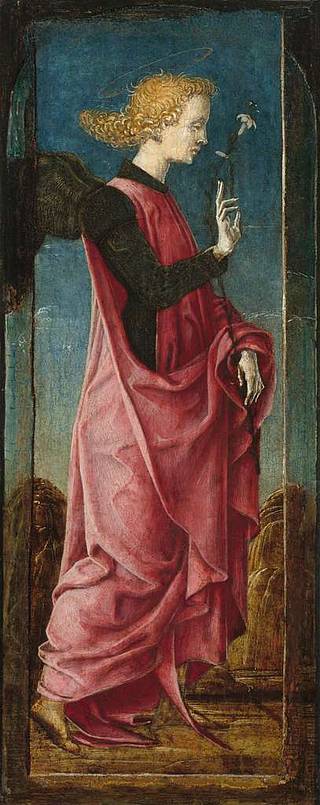
Similar
Cosmè Tura 035 - The Yorck Project Masterpieces of Painting
Summary
Annunciation
Public domain photograph of 15th-century art, medieval or early renaissance, free to use, no copyright restrictions image - Picryl description
Italian Renaissance painting is most often be divided into four periods: the Proto-Renaissance (1300–1425), the Early Renaissance (1425–1495), the High Renaissance (1495–1520), and Mannerism (1520–1600). The city of Florence is renowned as the birthplace of the Renaissance, and in particular of Renaissance painting. From the early 15th to late 16th centuries, Italy was divided into many political states. The painters of Renaissance Italy wandered Italy, disseminating artistic and philosophical ideas. The Proto-Renaissance begins with the professional life of the painter Giotto and includes Taddeo Gaddi, Orcagna and Altichiero. The Early Renaissance style was started by Masaccio and then further developed by Fra Angelico, Paolo Uccello, Piero della Francesca, Sandro Botticelli, Verrocchio, Domenico Ghirlandaio and Giovanni Bellini. The High Renaissance period was that of Leonardo da Vinci, Michelangelo, Raphael, Andrea del Sarto, Coreggio, Giorgione, the latter works of Giovanni Bellini, and Titian. The Mannerist period, dealt with in a separate article, included the latter works of Michelangelo, as well as Pontormo, Parmigianino, Bronzino and Tintoretto.
Cosme Tura was an Italian painter and sculptor born around 1430 in Ferrara, Italy. He is known for his distinctive style, which combined elements of Gothic and Renaissance art. Tura worked primarily in his hometown of Ferrara, where he was commissioned by the ruling Este family to create many of his most famous works. Tura's early works were heavily influenced by the Gothic style, with its emphasis on highly stylised figures and elaborate decoration. However, as he matured as an artist, Tura began to incorporate more Renaissance elements into his work, such as a greater focus on perspective and naturalism. One of Tura's most famous works is the cycle of frescoes in the Palazzo Schifanoia in Ferrara, depicting the months of the year and their corresponding signs of the zodiac. The frescoes are notable for their intricate detail and vibrant colours, as well as their incorporation of astrological symbolism. Tura also created many altarpieces and religious paintings, often featuring elongated figures and exaggerated poses. His sculptures, mostly created in collaboration with his brother Jacopo, were similarly stylised and expressive. Despite his significant contributions to the art world, Tura's work was largely forgotten after his death in 1495. It wasn't until the 20th century that his work was rediscovered and appreciated for its unique style and innovative techniques.
Tags
Date
Source
Copyright info






























